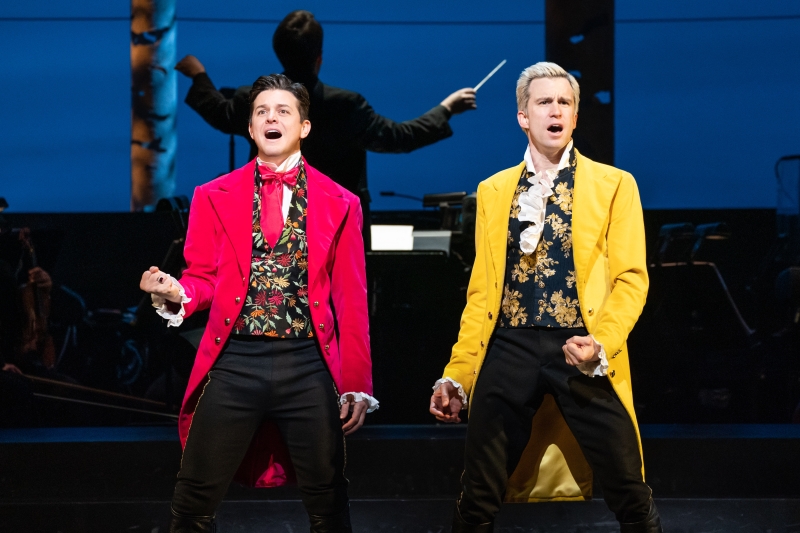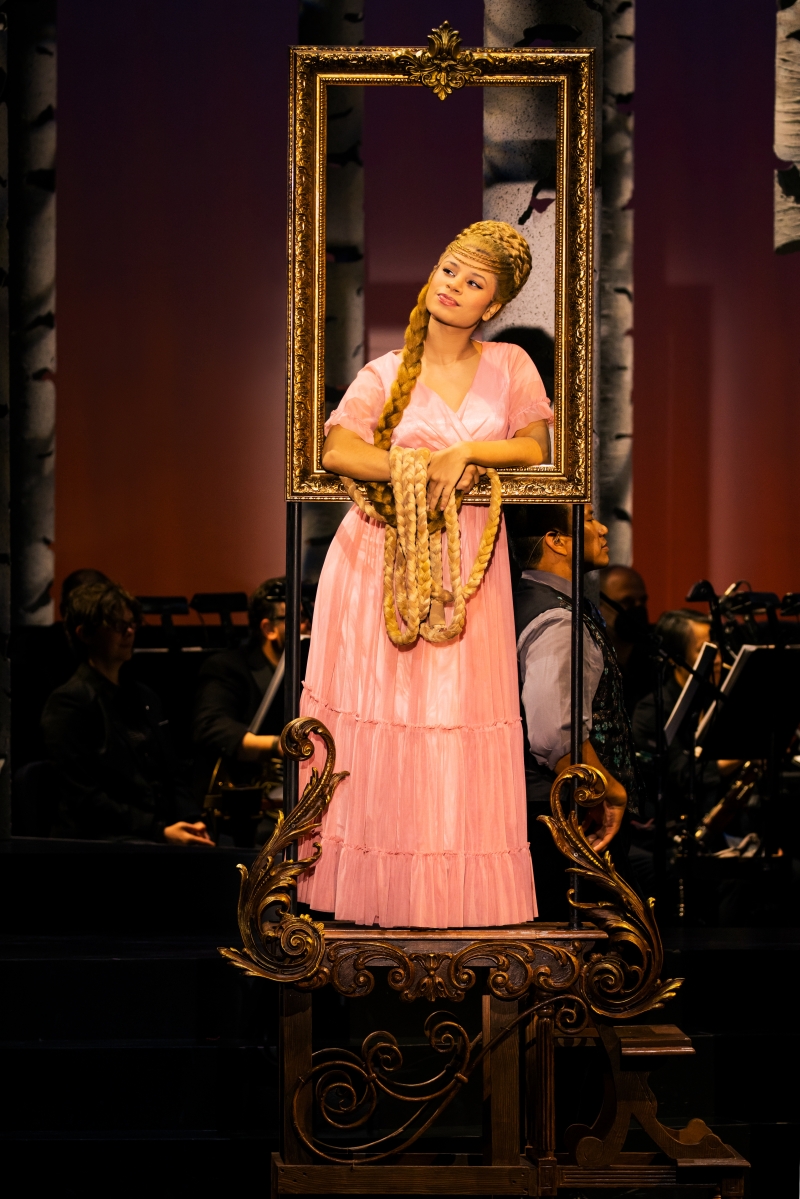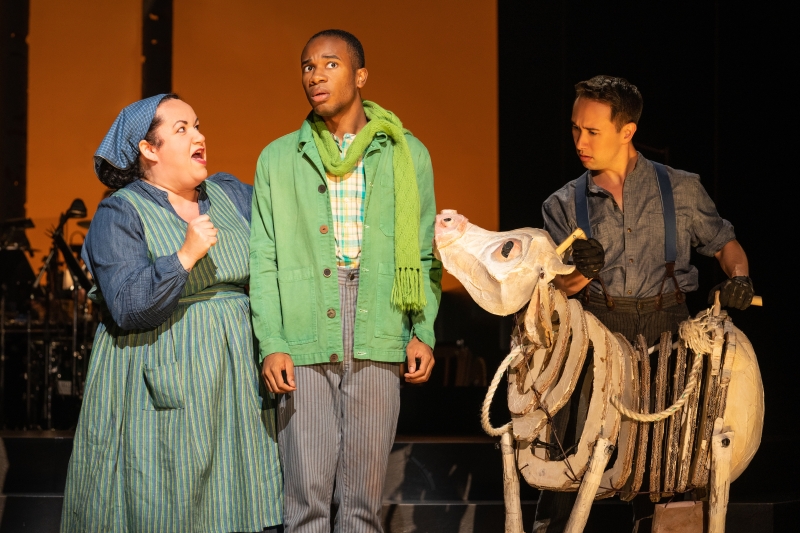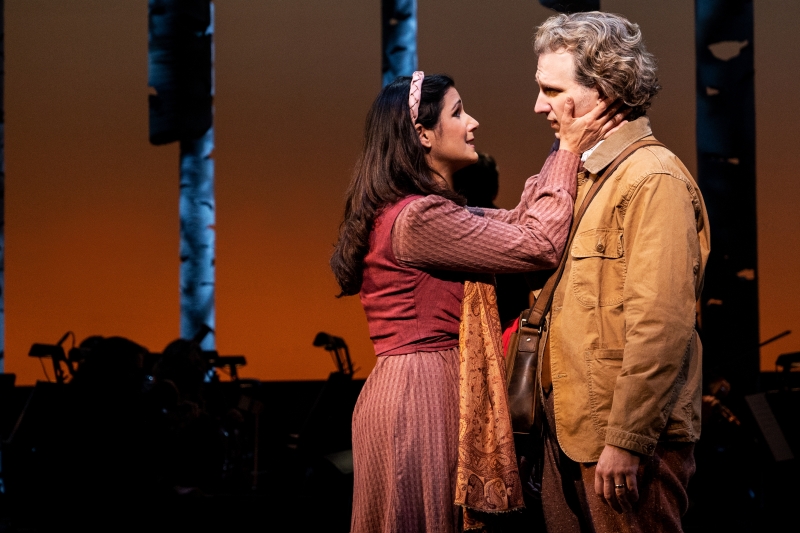Review: Fairy Tales Go Out of the Frying Pan and INTO THE WOODS at Dr. Phillips Center for the Performing Arts
When your wishes come true and you have everything you want, shouldn’t it be enough?

When INTO THE WOODS first graced the American stage in 1987, the concept of an epic, all-inclusive universe for various and different intellectual properties must have seemed largely alien to audiences. This was long before the days of comic-book-movie crossovers; this was a more innocent era when the most exciting merging of fictional universes saw Jessica Fletcher of “Murder, She Wrote” going to Hawaii for an episode of “Magnum, P.I.” Thus, even by the most conventional standards, INTO THE WOODS was innovative by its premise alone. It asked the audience to believe that these disparate fairy tales, all of which lived and breathed within their own, separate “Once Upon a Time”-iverses, could conceivably take place at the same time and not only share a setting, but share characters and interact in ways they had not before. No less than six fairy tales are unfolding on this stage, including an original one written specifically for INTO THE WOODS.

Our story begins in three households as the ever-present Narrator (David Patrick Kelly) introduces us to three of the central tales: Cinderella (Ellie Fishman), The Baker and His Wife (Sebastian Arcelus and Stephanie J. Block), and Jack (Cole Thompson). Cinderella wishes to go to the King’s festival, though she encounters resistance from her stepmother (Nancy Opel) and two stepsisters (Ta’Nika Gibson and Brooke Ishibashi). Jack’s Mother (Aymee Garcia) is forcing Jack to sell his cow, Milky White (Kennedy Kanagawa), as she no longer produces milk. The Baker and His Wife wish for a child, so they make a deal with The Witch Next Door (Montego Glover) to have one.
Within these three tales, other fairy tales weave in and out of the storyline. Little Red Riding Hood (Katy Geraghty) stops by the Baker’s shop before visiting her grandmother (Felicia Curry). Later on, after the Big Bad Wolf (Gavin Creel) has eaten both, the Baker comes across the cabin and helps set them free. In the meantime, during her quest to help her husband get ingredients for the Witch’s potion, the Baker’s Wife encounters Cinderella running away from the ball. And Jack makes an unwise deal with the Baker and His Wife for Milky White, resulting in the beanstalk of his fairy tale growing outside his house the next morning. He climbs it and discovers a whole other world above his own, returning with riches and gifts.
Eventually, we also discover that the Witch had long ago taken the Baker’s sister to raise as her own, a payback for the Baker’s father having stolen her vegetables years ago. This sister grew up isolated and alone in a tower, with ever-flowing golden hair and a voice as beautiful as she was. Her name is Rapunzel (Alysia Velez) and her Prince is… kind of dim (Jason Forbach) but in a goofy, puppy-dog-eyes kind of way. His brother (Gavin Creel again), paired up with Cinderella, is likewise a cupcake short of a baker’s dozen but makes up for it with relentless charm that turns on toward anyone in the room. They both try to one-up the other when it comes to who has the more challenging conquest with women.

A myriad of decisions and actions result in the expected “Happily Ever After” that most characters feels they’ve earned, while other characters get what the audience believes they deserved. The Baker and his Wife procured the ingredients for the Witch, who uses it to give them a child, but more importantly to restore her youth and beauty. Cinderella escapes her abusive household to marry her prince. Jack fells the giant after one too many trips to the sky world. Little Red Riding Hood goes gangster as a new defense mechanism. And Rapunzel – banished to the desert by her Witch mother – finds her blinded prince, but her tears restore his sight and they go riding into the sunset with their twin babies.
And, yet, it’s not enough. INTO THE WOODS opens its second act with an update on these characters. But it also asks the question of what happens beyond that happily ever after. When your wishes come true and you have everything you want, shouldn’t it be enough? Instead, we find that the Baker is a father filled with self-doubt on his parental abilities. Cinderella has found no purpose to living day in and day out in the castle. Jack longs for the world he left behind. Rapunzel suffers from post-traumatic stress disorder and leaves her husband and children to figure herself out.
Before anyone else can have a like-minded existential crisis, the Giant’s Wife has come down to earth to seek revenge on those who have wronged her. Everyone must find ways to escape and survive, whether it mean simply running away or turning in the guilty parties. No one wants to take the blame, but are willing to give it. Marriages break apart and families get broken. By the end, our Woods are a lot smaller now, as those left behind face the brave new world with a better understanding of themselves.

INTO THE WOODS deals with a variety of themes and issues within its packed storylines and dense cast of characters. Reluctant parenthood, loss of innocence, the dangers of wish fulfillment, infidelity and accidental death. All ripe for an episode of "thirtysomething." But the two most prevalent tales of INTO THE WOODS are a deconstruction of both The Hero’s Journey and The Heroine’s Journey. Through both the characters of Jack and Cinderella, we see how these models of storytelling unfold. Jack is our Hero of a Thousand Faces, a simple everyman who is plucked from his nowhere town to embark on a journey to a world and life that changes him, and he returns home a better man than he was before. Cinderella, our feminine Heroine, longs for what she believes may be a perfect world, discovers its reality is not what she wants, and re-invents herself to find the balance within that gives her true happiness.
As a result, it makes the most sense why lyricist Stephen Sondheim and book writer James Lapine ensured that only Cinderella and Jack have actual given names, whereas every other character gets identified simply by their attire (Little Red Riding Hood), profession (The Baker), or relationship to another character (Cinderella’s Stepmother). Think back to the players of this story. We never know if the Witch’s name is Hecate or Mavis or Karen. Cinderella’s Prince may be a Chad or a Cornelius. The Baker’s Wife surely might be Emily or Helen. But none of them are gifted the importance of a name because, though their journeys are just as involving and exciting to watch, they are ultimately reduced to playing archetypes. You need not know that Cinderella’s Stepmother could be named Estelle, only that she was cruel to her stepdaughter in favor of her own. Cinderella and Jack, on the other hand, have fully-realized arcs that make them the most developed characters across both acts of the musical. The audience understands their motivations, their wants, and what actions they take. They are the heroes of the story, if one must assign the heroic role to just two characters.
Rapunzel, I must bring up, is the sole exception to this rule. She is an outlier in the sense that her name becomes her role and her relationship to others. Those who know the Rapunzel tale (at least before Disney got their hands on it), always know that she is simply the prisoner in the tower. She functions solely as an obscure object of desire for the prince of her tale. She could have agency beyond the limitations the Witch has given her. But Sondheim and Lapine make sure to write her as a representation of that repressed, too-little-too-late sentiment. She embodies all the lost opportunity others may have, and thus, her name becomes her only freedom. By paradoxically giving the least-developed character a name, Sondheim and Lapine have shown that even their own rules of the musical are made to be broken.

Indeed, throughout much of INTO THE WOODS, characters grapple with the notion that the established way of things will be shaken up and changed. Little Red Riding Hood’s “I Know Things Now” suggests that in both on-the-nose assessments and beneath-the-surface readings. The Baker’s Wife outright says she is in the wrong story during “Any Moment.” The continuing crossing over of each character into another story results in a destabilization of the entire Woods. By the time our eleven o’clock number comes up, “No One Is Alone” questions everything that everyone knew by suggesting they take the steps forward into the unknown that will define the rest of their lives. And within the finale’s reprise of “No One Is Alone,” it carries within it what I believe to be the most truthful of Sondheim’s lyrics in both this show and his others.
For years, “Sometimes people leave you halfway through the wood / Do not let it grieve you, no one leaves for good” has been my favorite Sondheim lyric of all time. That’s a lofty assessment given the breadth of songs that Stephen Sondheim has written over the past seven decades. How does it beat timeless sentiment like West Side Story’s “Maria” or iconic patter of Company’s “Getting Married Today” or underrated gem from Evening Primrose’s “When”? Quite simply, for me it has always been the most upfront of the truthful lyrics that Sondheim’s written over the years. More importantly, it rests within a musical that outright tells the audience from the beginning that it will lie to you.

Not all lies are bad. In fact, sometimes it’s easier to take comfort in a lie that brings a smile rather than a truth that elicits a tear. But, mark my words, the “Once upon a time” that bellows at the beginning of INTO THE WOODS is a lie. A great lie, a lie worth repeating, but a lie nonetheless. Everything on that stage is a carefully crafted lie. Nothing on that stage is real. None of these characters exist. None of the situations ever happened. Yet, in the wonderful world of theatre, we have allowed ourselves to find truth in deception, to see the honesty within a fabrication. The elaborate nature of storytelling is built on making a lie seem as genuine as possible. No method of storytelling does this more so than the drama that unfolds on a live stage. We know these are actors. We know these woods are fake. We know that the story – passed down for generations and embellished or exaggerated as necessary – couldn’t possibly happen anywhere except within the realm of fiction.
But, my goodness, we love it.
Part and parcel of believing in the Great Lie is that childhood curiosity and wonderment instilled within each of us, usually when hearing these fairy tales for the very first time. “Once upon a time” suggests that this could have happened, intentionally vague and unreachable but then the characters come alive in a fantastical journey that we, too, wish we may take. We identify within the heroes and the villains the same traits in ourselves, sometimes in joy, other times in repulsion. And we are forced to reckon with the notion that sometimes it takes a lie to bring out the truth. If we’re going to be deceived, let the reaction to it be as truthful as possible. This is, in part, what makes INTO THE WOODS so beloved for its audiences. Its reinvention of these familiar familiar fairy tales invites us to look beyond the literal stories at play and to recognize the emotional truth that we live through it.

Since 1987, INTO THE WOODS has been revived time and again on Broadway and beyond. Whether it be a West End running or popular national tours or regional high school productions, the show has touched generations of viewers throughout the years thanks in part to its accessibility. The current US tour is based on the highly-popular 2022 revival at the St. James Theatre, itself a transplant from the New York City Center’s Encores! Production. With much of the closing Broadway cast in tow, INTO THE WOODS heads out on an extremely-limited ten-city tour that fortunately will call Orlando, Florida home for the week.
A record 16 of the 17 credited cast members are transplants from the Broadway run, including an astounding 97% of its behind-the-curtain crew. In essence, we are getting the bona fide Broadway show, from its stars to its set decorators, here in the heart of Florida. I cannot fathom a better way for local audiences to experience INTO THE WOODS.
Throughout the night, you could tell just how engaged the audience was with the show. They cheered right when the curtain opened. They hummed along to songs they knew (I, myself, was silently lip-syncing to “Giants in the Sky”). And they laughed. Time and again, at the littlest of reactions or the biggest of strides, they laughed. INTO THE WOODS can get heavy at times, but thanks to the talents of performers like Gavin Creel and Jason Forbach as the Two Princes (go ahead now), we were in for some fun. The two played their roles with a level of dim-witted foppishness that surely was exaggerated beyond the instructions on the page. But they did it with a gusto and a knowing wink that their characters are ridiculous, interchangeable, and altogether useless to the story. It was sheer delight watching them through both performances of “Agony” as they mugged for the proverbial camera, playing to the rafters with every kick and pose.

Likewise, Kennedy Kanagawa should not be overlooked as he brings Milky White to life through his masterful puppeteering. Milky White was never treated as a character in the same sense as Cinderella or even her stepsisters Lucinda and Florinda. The original 1987 production made him a static prop, a cow on wheels literally dragged around the stage with otherwise limited mobility. 2002’s revival was the first to place an actor in the role, hunched over and otherwise hidden but now mobile and able to have some degree of versatility on the stage. With the 2022 revival, a puppet has been designed that allows a live actor – Kanagawa has played him since the Encores! Days – now interacting with the rest of the cast. And he brings it. It’s a wonder watching how he manipulates the Milky White puppet as he’s using it; I’ve noticed that he dips his wrist up and down ever so slightly to give the illusion that the cow is breathing. But, in addition, he reacts to all the characters in character as Milky White. The looks of terror, the jokingly jovial smile, the utter shock when Milky White dies and he runs off as if he’s lost his sense of purpose on the stage. It’s a new and superior understanding of a character that, quite literally, was not a character at all until this production.
Of course, for every laugh, there should be a tear, as Walt Disney is wont to say. Audiences delighted in the fun of INTO THE WOODS, but they also invested themselves in its pathos. I don’t know how to best explain it, but there is an unmistakable gasping sound one can hear in a theatre when you know folks are collectively crying. Whatever speaks to us within INTO THE WOODS always elicits happy tears, and it spoke volumes last night.

Personally, for me, the story of the Baker and His Wife struck a chord. Perhaps it is due in large part to the natural chemistry of its two leads, Sebastian Arcelus and Stephanie J. Block. Married in real life, they have perfected the delivery of lines I’ve seen and practically memorized from the PBS filmed performance of original Broadway stars Joanna Gleason and Chip Zien. And yet, they made it feel fresh and alive, as if I were hearing it for the first time. It’s like rediscovering a song that you knew in your youth, but heard once more as an adult with a better understanding of what the lyrics now mean. To hear Block sing my favorite Sondheim lyrics of all time sent chills down my spine. At last, I could fully understand the loss of the Baker, as well as the strength he found within it. And it was a freeing moment, not just for the characters on the stage, but for myself as well.
Indeed, the vocal adrenaline from the entire cast has made this revival of INTO THE WOODS one that should not be missed. Montego Glover’s Witch adds a level of desperation to “Stay With Me” that allows the diva-ness of the song to shine without sacrificing the despair that her character is going through. Cole Thompson’s “Giants in the Sky” playfully addresses his Hero’s Journey and the more layered subtext of its folly. Ellie Fishman’s Cinderella turns “On the Steps of the Place” into a more cerebral contemplation better reflecting her inner turmoil against her outwardly pratfalls. And when “Your Fault” comes along as Arcelus, Geraghty, Thompson, and Fishman all battle for dominance, we can distinguish each voice amidst the frenzy before Glover silences them all to deliver a “Last Midnight” that shows why she’s on Broadway to begin with.

Every step of the INTO THE WOODS journey is one worth taking for the audience because it’s a step forward to a better understanding of why we love these stories, as well as how we relate to them. Sondheim and Lapine’s musical has endured for so long because, even within the framework of such a complex lie as “once upon a time,” we find the truth within it that allows us to still believe in it. This current US tour carries with it the calibre of Broadway talent now accessible, like INTO THE WOODS, to audiences beyond a land far, far away. If these woods happen to be in your… neck of the woods, I cannot recommend this show enough. Fortunately, for those of us in Central Florida, we still have a week to believe in the woods.
INTO THE WOODS plays at Dr. Phillips Center June 6 through 11. Tickets can be acquired online or at the box office, pending availability.
Reader Reviews
Videos

